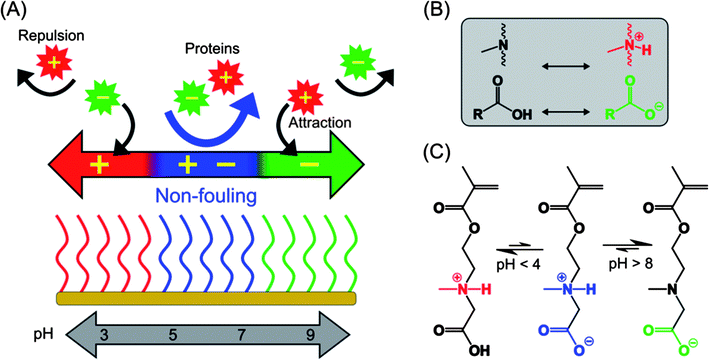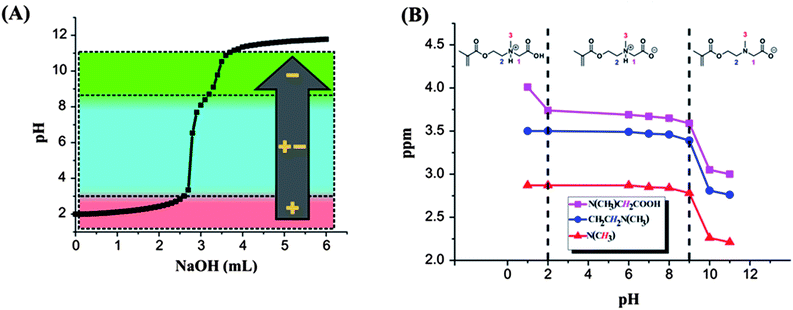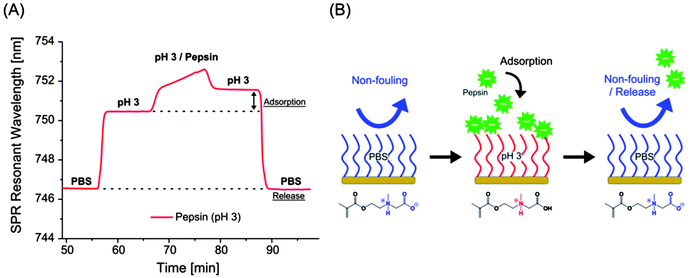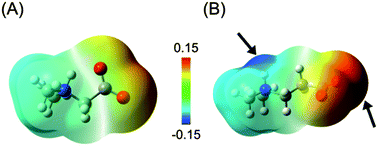Reversibly switchable polymer with cationic/zwitterionic/anionic behavior through synergistic protonation and deprotonation†
Harihara Subramanian
Sundaram
,
Jean-Rene
Ella-Menye
,
Norman D.
Brault
,
Qing
Shao
and
Shaoyi
Jiang
*
Department of Chemical Engineering, University of Washington, Box 351750, Seattle, Washington 98195-1750, USA. E-mail: sjiang@u.washington.edu; Tel: +1 206 616 6509
First published on 18th September 2013
Abstract
A polymer capable of fully and reversibly switching throughout the entire charge regime is highly desirable for many applications such as drug and gene delivery, controlled ion and molecular transport and tunable filtration membranes. It is essential that for biologically relevant applications the polymer needs to be nonfouling. However, conventional nonfouling zwitterionic polymers have a permanently positive quaternary nitrogen center, making it impossible to switch between charges. Here, we present a rationally designed polymer with a tertiary amine and a carboxylic acid, which is capable of reversibly switching among three distinct charged states, viz., cationic, zwitterionic and anionic, and importantly maintaining the zwitterionic state under physiological pH conditions. Oppositely charged proteins adsorbed on a charged surface selectively can be completely removed by switching the surface to the zwitterionic state. We have also found that these two moieties (i.e., a tertiary amine and a carboxylate moiety) stimulate each other synergistically to achieve a strongly zwitterionic state under physiological conditions and to resist non-specific protein adsorption from undiluted blood plasma and serum when they are close to each other.
Introduction
Smart polymers exhibit changes in behavior in response to external stimuli such as temperature, pH, redox chemistry, etc., enabling control over properties such as the transport of ions and molecules, changes in wettability, and the adhesion of different species among others.1 These functionalities are being used for many different applications including drug delivery,2 gene delivery,3,4 ion transport,5,6 protein separation7–11 and nonfouling coatings for immensely different biological12–19 and marine20–24 environments. Most smart polymers reported exhibit only two reversible or irreversible charged states. For example, a permanently charged cationic polymer with a hydrolysable group was shown to have antimicrobial properties and upon hydrolysis become zwitterionic and exhibit ultra low fouling properties.7 Similarly, a cationic polymer brush with a photo-cleavable group was previously demonstrated to become anionic upon exposure to UV radiation and enable the adsorption of oppositely charged dyes and proteins.8 A polymer having randomly distributed groups of temperature sensitive NIPAM (N-isopropyl acrylamide) and pH sensitive acrylic acid was shown to selectively adsorb positively charged proteins above the lower critical solution temperature (LCST) of the NIPAM groups.9 The oxidation and reduction states of a conducting polymer surface coating have previously enabled control over the wettability of oil droplets.25 In all of these examples above the polymer switches between only two states.Di-block copolymers consisting of tertiary amine and carboxylic acid based monomers have been shown to possess two different pKa values, one for each corresponding monomer. These polymers enable reversible micelles to form in solution by adjusting the pH. At the isoelectric point, the two segments become cationic and anionic and the resulting polymer will become charge neutral if the number of units of each block are the same.26 However, a single polymer capable of fully and reversibly switching throughout the entire charge regime, from cationic to neutral zwitterionic to anionic, is highly desirable for applications such as gene and drug delivery, controlled ion and molecular transport and tunable filtration membranes. For biologically relevant applications it is necessary that the polymer exhibits excellent nonfouling properties in complex media. Ultra low fouling properties in complex media, an absolute requirement for biological applications, have been achieved by only few materials, prominently, zwitterionic carboxybetaine polymers.7,12,27,28 However, conventional nonfouling zwitterionic polymers are composed of monomers containing a permanent positively charged quaternary amine and a negatively charged group, to ensure a zwitterionic structure under physiological conditions. Due to the presence of the permanently charged group, it is impossible to achieve a fully switchable material among all possible charged states. An amino acid based polymer has previously achieved reversible charge switching among all three charged states, but with weak zwitterionic behavior,29 for selective ion transport.6 However, this material achieved the zwitterionic state around pH 5, thus not being relevant in most biological environments. A polymer capable of reversibly switching among distinctive charged states while maintaining a strong zwitterionic state in physiological conditions would be able to achieve selective adsorption of charged proteins from a mixture and then their corresponding complete release.
To this end, we designed a single polymer containing a tertiary amine and a carboxylic acid separated by a one carbon spacer (Scheme 1). The fully reversible charged states were generated by taking advantage of the two distinct pKa values of the tertiary amine and carboxylic acid. The tertiary amine can exist in both positive and neutral states while the carboxylic acid can exist in anionic and neutral forms. The ability of both groups to undergo reversible protonation or deprotonation with pH also provides a means for hiding positive and negative charges. When the number of carbon spacers between the tertiary amine and the carboxylic acid groups is small enough, such as one, both sites can stimulate one another and thus affect their protonation and deprotonation states (i.e., a synergistic effect). Hence, the combination of these two moieties in a single compound presents a distinctly new material with many unique properties. For the first time, we present a single new material capable of full-charge-reversible switching for selective protein adsorption over a wide range of pH conditions which can also achieve ultra low fouling properties to undiluted human plasma and serum under physiological conditions.
Our studies in this work addressed several questions: (a) in which pH range will the polymer switch reversibly from cationic to zwitterionic to anionic, and will the zwitterionic state occur between pH 7 and 8 which is necessary for relevant biological applications? (b) Will the zwitterionic state of the new polymer behave like conventional zwitterions containing quaternary amines and will this polymer be strong (zwitterionic) enough to resist nonspecific protein adsorption from undiluted human plasma and serum? (c) What structural features (e.g., spacer) induce the synergism between tertiary amine and carboxylic acid groups. The goals of this work are to demonstrate that this new polymer presents unique capabilities, such as i) fully reversible switching behavior between the selective adsorption and resistance of charged bodies, via adjusting the pH of the medium, and ii) ultra-low fouling properties in complex media, similar to conventional zwitterionic materials. Scheme 1A illustrates the expected response of the polymer to proteins of opposite charges at either end of the charge spectrum and the nonfouling behavior in the zwitterionic state. The core reversible chemistry hypothesized and the predicted charged states of the monomer are shown in Scheme 1B and C.
Results and discussion
The monomer (CBMA-1-TAM, where CBMA, 1, and TAM stand for carboxybetaine methacrylate, the number of carbon spacers, and tertiary amine, respectively) solution was first titrated against sodium hydroxide to reveal the two expected pKa values. As shown in Fig. 1A, the titration revealed pKa values of ∼2.6 and ∼8.7 for the carboxylic acid and amine groups, respectively. This indicates that the monomer exists as a cationic (low pH), zwitterionic (moderate pH), and anionic (high pH) form depending on the environmental conditions.To further verify the pH range for the different charged states of CBMA-1-TAM, 1H-NMR was used to monitor the chemical shifts of three sets of protons (labeled 1, 2 and 3 in Fig. 1B and S1†) adjacent to the charged groups. The results indicated three distinct regions. From pH 1 to 2, tertiary amine protonation made the monomer cationic thereby electronically deshielding all three protons. Between pH 2 and 9, the monomer became zwitterionic as indicated by only proton 1, near the electron-rich carboxylate, revealing any significant shielding effects. Beyond pH 9, the monomer became anionic, again resulting in a chemical shift for all three neighboring protons to the amine as it was deprotonated which leveled out with further increase in pH. This pattern in peak shift confirms the existence of the three different charged states between pH 1 and pH 11. Noteworthy, the titration and 1H-NMR data collectively indicate a zwitterionic species under relevant biological conditions (pH 6–8). It should be emphasized that the monomer behavior could be slightly different from a polymer brush on the surface which has restricted movement due to the denser grafting on the surface as well as effects from overlapping side-chains. However, this provided fundamental information necessary for subsequently studying the polymer system.
Polymer brushes were prepared using photopolymerization30 (Fig. S2†) to provide further evidence of the existence of three charged states via protein fouling experiments with surface plasmon resonance (SPR) spectroscopy. Iniferter polymerization is one among the controlled living radical polymerization (CLRP) methods compatible with many of the functional monomers.31–33 The polymerization was performed in methanol and water. The polymerization was carried out at different intervals to vary the thickness. The solvent ratio was known to affect the change in graft density of the grown polymer brushes. The concentration of the monomer used was kept constant throughout all the experiments at 160 mM. The polymerization kinetics using 10% water in methanol is given in Fig. S2.†
The thickness could be adjusted from 15 nm to 60 nm by changing the polymerization time. The pH dependent protein adsorption was studied between pH 3 and pH 9 using lysozyme (pI ∼ 11) and pepsin (pI ∼ 1).10 These proteins were selected such that a set of proteins are oppositely charged at any given pH between pH 3–9. Hence, lysozyme was the positively charged protein while pepsin formed the negatively charged counterpart over the entire pH range. Based on the expected charge of the proteins and the corresponding fouling behavior, combined with the monomer titration and 1H-NMR data, it was possible to study the surface charge-pH effect of the polymer film made from CBMA-1-TAM. These results are summarized in Table 1. SPR sensorgrams showing the surface adsorption of oppositely charged proteins at pH 3 and pH 9 are shown in Fig. S3.†
| a Due to pepsin denaturation issues at pH 9, BSA (pI ∼ 4.7) was used for this particular experiment. |
|---|
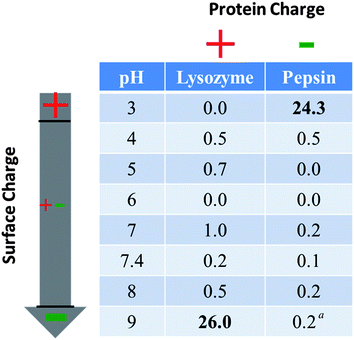
|
The data given in Table 1 show that between pH 4 and pH 8, neither the positively charged protein lysozyme nor the negatively charged pepsin adsorbed onto the surface. This indicates charge neutrality of the brush under these conditions. Based on the monomer titration curve, the NMR study, and the pH dependent fouling experiments using SPR, this result is due to the polymer brushes exhibiting zwitterionic structure and showing protein resistance from pH 4 to pH 8. However, the fouling at pH 3 and pH 9 was very different. At pH 3, the negatively charged pepsin adsorbed heavily (24 ng cm−2) whereas the positively charged lysozyme showed only negligible binding. This clearly shows that the surface is positively charged at pH 3, attracts the negatively charged protein and repels the positively charged protein. At pH 9, only positively charged lysozyme was strongly adsorbed on the surface (26 ng cm−2) while the negatively charged BSA (used due to the denaturation issues with pepsin at pH 9) showed negligible binding (0.2 ng cm−2). This demonstrates that the surface is negatively charged at pH 9. These protein adsorption experiments illustrate that the polymer exists as cationic, zwitterionic and anionic forms over discrete pH ranges. It should be pointed out that one can tune the pH range at which the polymer is positive, negative and zwitterionic by changing its structure.
Noteworthy, especially for protein separation applications, as an example, pepsin which bound to the surface at pH 3 was completely removed by changing the pH to 7.4. The SPR sensorgram is shown in Fig. 2A along with a scheme (Fig. 2B) showing the reversible switching behavior of the polymer. A base line was established first and then pepsin was flowed on the surface at pH 3 which clearly showed a definite adsorption of pepsin. Then the surface was washed with PBS (pH 7.4) and now the base line reached the initial established level, revealing complete removal of pepsin from the surface. Hence, by utilizing the reversible charge switching of the polymer it is possible to adsorb and then completely remove a given protein from the polymer surface.
Collectively, the data from Fig. 1 and Table 1 reveal a novel smart surface which can be switched among cationic, zwitterionic and anionic states simply by changing the pH. It should be emphasized here that since the surface was tested between pH 3 and 8 using single proteins, fouling behaviors will be quite different for complex media such as undiluted blood plasma and serum. Thus the nonfouling behaviour was further tested with undiluted plasma and serum at physiological pH (pH 7.4).
Human plasma and serum are far more complex than individual proteins and offer a much greater challenge to resisting nonspecific adsorption. Conventional zwitterionic polymers (carboxybetaine and sulfobetaine) have been shown to be ultra low fouling against human serum and plasma which is vital for biomedical applications.34 To further explore the extent of the zwitterionic behavior of CBMA-1-TAM, the polymer brush was subjected to fouling experiments with undiluted human plasma and serum. The surface showed only 5.0 ± 2.1 ng cm−2 fouling for serum and undetectable adsorption for plasma (Fig. 3), thus providing ultra low fouling properties and demonstrating strong zwitterionic characteristics, akin to conventional zwitterions.
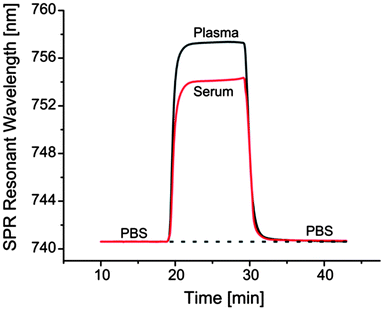 | ||
| Fig. 3 Fouling tests on the polymeric surface with undiluted human plasma and serum. Typical SPR sensorgrams for fouling experiments with undiluted human plasma and serum. | ||
We also compared CBMA-TAMs with one and two carbon spacers based on their behavior and performance. Their electrostatic potential surfaces are shown in Fig. 4. The results indicate a more uniform charge distribution for the single spacer as expected (Fig. 4A). The figure also indicates highly localized charge density, such as dark blue (electron deficient) and dark red (electron rich), near the nitrogen proton and the carboxylate for the two-spacer monomer (Fig. 4B). The radial distribution function for the intermolecular interaction of the nitrogen proton with that of carboxylate is plotted in Fig. S4.† Unlike CBMA-2 with a quaternary amine,35 this promotes intermolecular interactions among CBMA-2-TAM groups (Fig. 4), leading to aggregation and fouling at pH 7.4 (Fig. S5†). The synergistic interaction between tertiary amine and carboxylic acid groups is thus evident when they are separated by one spacer. The charge densities are well distributed when the number of carbon spacers is one whereas there is no such interaction when the carbon spacer number is two. The two spacer polymer (CBMA-2-TAM) shows a fouling of 51 ng cm−2 and 45 ng cm−2 for fibrinogen and lysozyme respectively at pH 7.4 whereas the one spacer polymer (CBMA-1-TAM) showed ultra low fouling even for undiluted plasma and serum.
Conclusions
In conclusion, we present the design, synthesis and characterization of a novel reversibly switchable material. Due to its possessing a tertiary amine and a carboxylic acid group separated by a single carbon spacer, the material reversibly switches among cationic, zwitterionic and anionic forms depending on pH and the material behaves as perfectly zwitterionic at physiological pH via a synergistic mechanism. The monomer clearly indicated a synergistic mechanism between the tertiary amine and the carboxylic acid groups, thereby offering a convenient approach for controlling the pH-dependent properties. Subsequent quantum chemical calculations indicated that the stable zwitterionic state was enabled by charge transfer. These polymer brushes showed ultra low fouling properties to undiluted human serum and plasma under physiological conditions. The charge switching ability of the polymer combined with the ultra low fouling properties at physiological pH make this material desirable for specialized applications.Acknowledgements
This work was supported by the Office of Naval Research (N000141210441), National Science Foundation (DMR 1005699), and U.S. Army Natick Soldier Research, Development and Engineering Center.Notes and references
- M. A. C. Stuart, W. T. S. Huck, J. Genzer, M. Muller, C. K. Ober, M. Stamn, G. B. Sukhorukov, I. Szleifer, V. V. Tsukruk, M. Urban, F. Winnik, S. Zauscher, I. Luzinov and S. Minko, Nat. Mater., 2010, 9, 101–113 CrossRef PubMed.
- J. H. Ryu, R. T. Chacko, S. Jiwpanich, S. Bickerton, R. P. Babu and S. Thayumanavan, J. Am. Chem. Soc., 2010, 132, 17227–17235 CrossRef CAS PubMed.
- D. G. Anderson, A. Akinc, N. Hossain and R. Langer, Mol. Ther., 2005, 11, 426–434 CrossRef CAS PubMed.
- D. W. Pack, A. S. Hoffman, S. Pun and P. S. Stayton, Nat. Rev. Drug Discov., 2005, 4, 581–593 CrossRef CAS PubMed.
- M. Motornov, T. K. Tam, M. Pita, I. Tokarev, E. Katz and S. Minko, Nanotechnology, 2009, 20, 434006–434016 CrossRef PubMed.
- A. Calvo, B. Yameen, F. J. Williams, G. J. A. A. Soler-Illia and O. Azzaroni, J. Am. Chem. Soc., 2009, 131, 10866–10868 CrossRef CAS PubMed.
- (a) G. Cheng, H. Xue, Z. Zhang, S. Chen and S. Jiang, Angew. Chem., 2008, 120, 8831–8834 CrossRef; (b) Z. Q. Cao, N. Brault, H. Xue, A. Keefe and S. Jiang, Angew. Chem., Int. Ed., 2011, 50, 6102–6104 CrossRef CAS PubMed.
- K. Nagase, S. F. Yuk, J. Kobayashi, A. Kikuchi, Y. Akiyama, H. Kanazawa and T. Okano, J. Mater. Chem., 2011, 21, 2590–2593 RSC.
- Y. Xu, Y. Hoshi and C. K. Ober, J. Mater. Chem., 2011, 21, 13789–13792 RSC.
- T. Ekblad, O. Andersson, F. Tai, T. Ederth and B. Liedberg, Langmuir, 2009, 25, 3755–3762 CrossRef CAS PubMed.
- M. Y. Chen and M. J. Sailor, Anal. Chem., 2011, 83, 7186–7193 CrossRef CAS PubMed.
- S. Jiang and Z. Cao, Adv. Mater., 2010, 22, 920–932 CrossRef CAS PubMed.
- Biomaterials Science – An Introduction to Materials in Medicine, ed. B. D. Ratner, A. S. Hoffman, F. J. Schoen and J. E. Lemons, Elsevier, Amsterdam, 2nd edn, 2004, pp. 237–246 Search PubMed.
- B. D. Ratner and S. J. Bryant, Annu. Rev. Biomed. Eng., 2004, 6, 41–75 CrossRef CAS PubMed.
- K. L. Prime and G. M. Whitesides, Science, 1991, 252, 1164–1167 CrossRef CAS.
- E. Ostuni, R. G. Chapman, R. E. Holmlin, S. Takayama and G. M. Whitesides, Langmuir, 2001, 17, 5605–5620 CrossRef CAS.
- R. E. Holmin, X. X. Chen, R. G. Chapman, S. Takayama and G. M. Whitesides, Langmuir, 2001, 17, 2841–2850 CrossRef.
- K. Ishihara, N. P. Ziats, B. P. Tierney, N. Nakabayashi and J. M. Anderson, J. Biomed. Mater. Res., 1991, 25, 1397–1407 CrossRef CAS PubMed.
- T. Ueda, H. Oshida, K. Kurita, K. Ishihara and N. Nakabayashi, Polym. J., 1992, 24, 1259–1269 CrossRef CAS.
- S. Krishnan, C. J. Weinman and C. K. Ober, J. Mater. Chem., 2008, 18, 3405–3413 RSC.
- C. M. Grozea and G. C. Walker, Soft Matter, 2009, 5, 4088–4100 RSC.
- C. M. Magin, S. P. Cooper and A. B. Brennan, Mater. Today, 2010, 13, 36–44 CrossRef CAS.
- J. A. Callow and M. E. Callow, Nat. Commun., 2011, 2, 244 CrossRef PubMed.
- A. Rosenhahn, S. Schilp, H. J. Kreuzer and M. Grunze, Phys. Chem. Chem. Phys., 2010, 12, 4275–4286 RSC.
- M. Liu and L. Jiang, Adv. Funct. Mater., 2010, 20, 3753–3764 CrossRef CAS.
- A. B. Lowe, N. C. Billingham and S. P. Armes, Macromolecules, 1998, 31, 5991–5998 CrossRef CAS.
- J. Ladd, Z. Zhang, S. Chen, J. C. Hower and S. Jiang, Biomacromolecules, 2008, 9, 1357–1361 CrossRef CAS PubMed.
- H. Vaisocherova, W. Yang, Z. Zhang, Z. Cao, G. Cheng, M. Piliarik, J. Homola and S. Jiang, Anal. Chem., 2008, 80, 7894–7901 CrossRef CAS PubMed.
- B. Yameen, M. Ali, R. Neumann, W. Ensinger, W. Knoll and O. Azzaroni, J. Am. Chem. Soc., 2009, 131, 2070–2071 CrossRef CAS PubMed.
- J. E. Krause, N. D. Brault, Y. Li, H. Xue, Y. Zhou and S. Jiang, Macromolecules, 2011, 44, 9213–9220 CrossRef CAS.
- N. Luo, J. B. Hutchison, K. S. Anseth and C. N. Bowman, Macromolecules, 2002, 35, 2487–2493 CrossRef CAS.
- T. Otsu, J. Polym. Sci., Part A: Polym. Chem., 2000, 38, 2121–2136 CrossRef CAS.
- S. B. Rahane, S. M. Kilbey and A. T. Metters, Macromolecules, 2005, 38, 8202–8210 CrossRef CAS.
- W. Yang, H. Xue, W. Li, J. Zhang and S. Jiang, Langmuir, 2009, 25, 11911–11916 CrossRef CAS PubMed.
- A. White and S. Jiang, J. Phys. Chem. B, 2011, 115, 660–667 CrossRef CAS PubMed.
Footnote |
| † Electronic supplementary information (ESI) available: Experimental procedures and details of simulation studies. See DOI: 10.1039/c3sc52233d |
| This journal is © The Royal Society of Chemistry 2014 |

